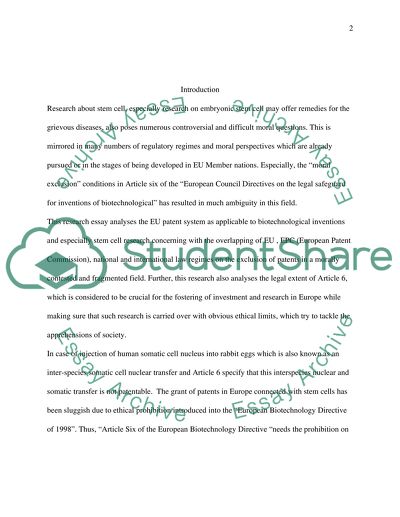Cite this document
(The Directive on the Legal Protection of Biotechnological Inventions Essay, n.d.)
The Directive on the Legal Protection of Biotechnological Inventions Essay. https://studentshare.org/biology/1566279-article-61-of-the-directive-on-the-legal-protection-of-biotechnological-inventions-9844ec-and-article-53a-of-the-european-patent-convention-exclude-from-patentability-inventions-the-commercial-exploitation-of-which-would-be-contrary-to-morality
The Directive on the Legal Protection of Biotechnological Inventions Essay. https://studentshare.org/biology/1566279-article-61-of-the-directive-on-the-legal-protection-of-biotechnological-inventions-9844ec-and-article-53a-of-the-european-patent-convention-exclude-from-patentability-inventions-the-commercial-exploitation-of-which-would-be-contrary-to-morality
(The Directive on the Legal Protection of Biotechnological Inventions Essay)
The Directive on the Legal Protection of Biotechnological Inventions Essay. https://studentshare.org/biology/1566279-article-61-of-the-directive-on-the-legal-protection-of-biotechnological-inventions-9844ec-and-article-53a-of-the-european-patent-convention-exclude-from-patentability-inventions-the-commercial-exploitation-of-which-would-be-contrary-to-morality.
The Directive on the Legal Protection of Biotechnological Inventions Essay. https://studentshare.org/biology/1566279-article-61-of-the-directive-on-the-legal-protection-of-biotechnological-inventions-9844ec-and-article-53a-of-the-european-patent-convention-exclude-from-patentability-inventions-the-commercial-exploitation-of-which-would-be-contrary-to-morality.
“The Directive on the Legal Protection of Biotechnological Inventions Essay”. https://studentshare.org/biology/1566279-article-61-of-the-directive-on-the-legal-protection-of-biotechnological-inventions-9844ec-and-article-53a-of-the-european-patent-convention-exclude-from-patentability-inventions-the-commercial-exploitation-of-which-would-be-contrary-to-morality.


